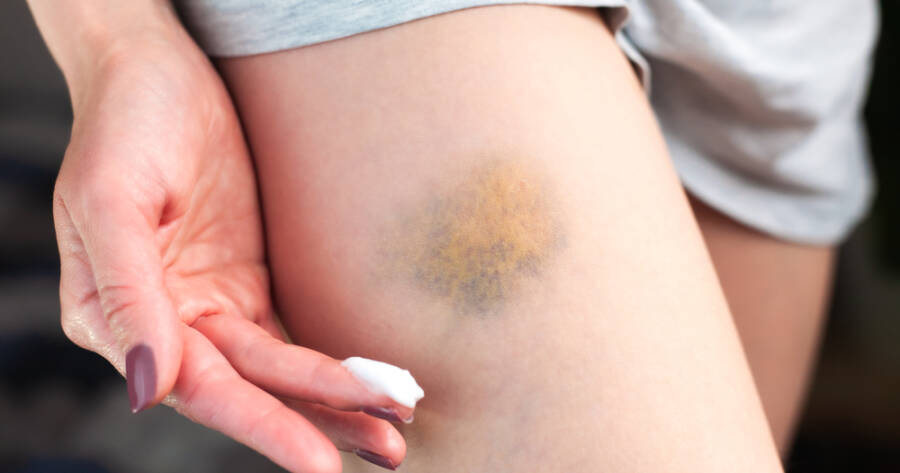Bruises are common skin injuries resulting from trauma to blood vessels under the skin. These marks can be painful and unsightly. While bruises usually heal without intervention, there are ways to accelerate the healing process. Home remedies and simple techniques can reduce the visibility and discomfort of bruises. These methods are aimed at speeding up recovery. Explore at home remedies for bruises today!
What Are Bruises?
A bruise, also called a contusion, occurs when an impact breaks blood vessels beneath the skin. Blood leaks into surrounding tissues, creating the familiar blue, purple, or yellow mark. Bruises typically change color as they heal, indicating the body’s natural recovery process. Understanding the stages of bruise healing is key in determining the best course of action to get rid of bruises.
How To Get Rid of Bruises
When you sustain a bruise, quick action can make a difference. Apply a cold compress to the affected area as soon as possible. This method reduces blood flow to the area, minimizing the bruise’s size. Keep the compress on for about 15 minutes and repeat several times within the first 24 hours.
Elevation and Rest
Elevating the bruised area above the heart level helps reduce swelling and pain. Gravity assists in draining excess fluid, aiding in faster recovery. Along with elevation, rest is crucial. Limiting movement in the affected area prevents further injury and allows healing to occur efficiently.
Natural Remedies
Several natural remedies are believed to be effective in treating bruises. Arnica, a well-known homeopathic remedy, is often used to reduce swelling and speed up healing. Aloe vera, known for its soothing properties, can also be applied to the bruise. Always do a patch test first to ensure you’re not allergic to these remedies.
Over-the-Counter Solutions
For additional relief, over-the-counter products can be beneficial. Pain relievers like acetaminophen can alleviate discomfort associated with bruises. Topical creams containing vitamin K or arnica can be applied to the bruised area. These products are believed to help in the reabsorption of blood and can reduce discoloration.
Heat Therapy
After 48 hours, switch from cold to heat therapy. Applying a warm compress or heating pad increases blood flow, helping to clear away trapped blood. Use heat therapy for about 10 to 15 minutes at a time. This method promotes healing and can alleviate stiffness in the affected area.
Diet and Hydration
Your diet plays a crucial role in the healing process. Foods rich in vitamin C and vitamin K aid in the body’s repair mechanisms. Hydration is equally important. Drinking plenty of water helps flush out toxins and speeds up the healing of bruises. Aim for at least 8 glasses of water a day.
Compression and Protection
Gently wrapping the bruised area with an elastic bandage can help reduce swelling and provide support. Ensure the wrap is snug but not too tight, as excessive compression can impede blood flow. Protecting the bruise from further injury is crucial. Avoid contact sports or activities that might aggravate the injury until it has fully healed. This care can prevent the bruise from worsening and aid in a smoother recovery process.
Gentle Exercise
Once the initial pain subsides, gentle movement can be beneficial. Exercise increases blood flow, aiding the body in healing the bruise. However, avoid strenuous activities that might exacerbate the injury. Opt for light activities like walking or stretching.
Mindful Skincare
Skin care plays a subtle but important role in managing bruises. Avoid hot showers or baths, as high temperatures can increase inflammation. Instead, opt for lukewarm water to soothe the area. Additionally, gentle massage around the bruised area, not directly on it, can improve circulation. Be cautious with skincare products; avoid applying harsh chemicals or irritants to the bruised area. Nurturing the skin promotes a healthy healing environment, facilitating quicker recovery from bruises.
When To Seek Medical Attention
Most bruises are harmless and will heal on their own. However, if you notice unusually large or painful bruises or if bruises appear without any known trauma, seek medical attention. These could be signs of an underlying medical condition. Persistent pain or swelling around the bruise also warrants a visit to the doctor.
Final Thoughts
Knowing how to get rid of bruises effectively can reduce discomfort and improve healing time. Home remedies, combined with proper care and attention, are usually sufficient for treating bruises. Remember, while these tips can aid in recovery, patience is key. It’s important to allow your body the time it needs to heal naturally.
